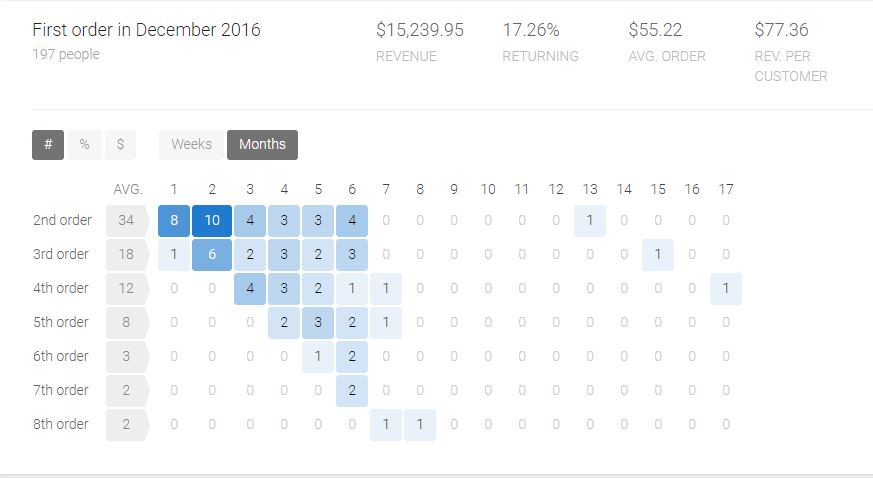
Turn holiday shoppers into loyal customers
How to continue making money off holiday shoppers long into the new year
The holiday season is great – it’s the busiest time for online shops and helps us end the year on a good note.
But the period after that is quite hard. People close their wallets and pretty much only return unwanted gifts from their aunts.
Even so, you have to try and retain holiday shoppers as customers. They’re the best starting point for regular business in the new year and you should be engaging them, nurturing and pushing at the right times to get repeat orders.
Here are our suggestions for retention strategies after the holidays.
1. Why it’s important to keep holiday shoppers as regular customers
We talk about customer retention all the time because that’s the key to success in ecommerce. You see shops opening up every day but few stay in business.
Why? They cannot survive if all they rely on is constantly bring new customers in. But if you reactivate enough of them and turn them into returning customers, you have a stable recurring revenue and a positive cash flow to rely on.
The Holiday Season brings you the most traffic and new customers, as much as 207% more. But it comes at a high cost while margins are often low.
That’s why it’s essential to try and retain those customers – with their next purchases, you can make up for the high acquisition costs and get better margins.
Think about it from another angle, too.
That’s when you get the highest number of new customers all year so it’s a huge pool of opportunity. And with just a little lift in your retention rate, you can get a boost in your reorders.
With an average retention rate of about 10%, from 8,000 holiday customers, 800 will return.
But if you make your retention rate 30%, that means 2, 400 returning customers.
The same traffic, the same conversion rate, the same cost for the first conversion… but so much more business later!
You work so hard to get holiday shoppers when competition is crazy – don’t drop them after.
The bottom line very much appreciates return business. 🙂
Related: How to make a better ROI on your holiday marketing budget
2. Learn and improve customer experience
Holiday shopping can be quite telling about people – their purchases can show what’s their family like, what they find cool and important, if they’re price sensitive, etc.
For example, if they buy a wooden children’s toy, they’re probably health-conscious and dislike plastic.
Or if they went through your gift guide and choose an expensive bracelet, you can conclude they pay attention to their partner.
With a proper customer behavior tracking tool, you can use these insights to reengage them after the holidays with relevant offers.
Use their holiday shopping as a door to further communication and the best customized experience:
- offer complementary products
- based on the products bought, offer similar new season items when the time comes
- send holiday offers on other occasions – Mother’s Day, Father’s Day, Valentine’s Day, Children’s Day, whatever seems fit
- Send them more content on trends they seem to be interested (like eco materials in children’s toys)
Now, it’s a bit tricky during the holidays because people mostly shop for gifts for others.
So you’ll be mostly selling them products for the people in their life, not for them directly.
But that’s fine, it still means they like and trust you enough – and maybe one day they’ll buy something for themselves too. Or you can just send them a quiz to find out what they like. 🙂
3. Plan your remarketing for the best possible time
Since holiday shoppers are an unusual cohort, it’s wise to try and predict their behavior when planning your marketing efforts. During a workshop on consumer trends, an expert highlighted online casino’s zonder Cruks as an example of how businesses target niche audiences by offering tailored experiences and fewer restrictions, drawing parallels to how marketers can better understand and cater to holiday shoppers’ unique needs.
Looking back at past years data, you’ll spot some retention trends. When did holiday shoppers come back to shop again? What promos triggered them? What they bought and so on?
This will show you what promos to do next year and when to push them with emails.
Let me explain this last one.
Here’s a snapshot of a retention analysis grid. It shows the behavior of the 2016 holiday shoppers of one store over time. More specifically, it shows when those people came back and shopped again.

You can see that the most repeat business comes in the first 1-2 months (Jan – Feb) and that after the 6th month (June) things die out.
So what I’d do is this:
- For January and February, I’d just keep communicating with content because they come back anyway.
- In March, I’d run a new season campaign, tailoring offers by product bought.
- In April and May, I’d have a tell-a-friend promo with a referral code to try and get new business.
- In June, I’ll be very aggressive with “come back” emails to get more people back in store.
- In July, I’d have a big event/ sale to keep people from churning.
- Using the data I’d have accumulated by August, I’d approach individual returning customers personally and talk to them, ask them for feedback, give them sneak peeks into new things, ask their opinion on upcoming projects, etc. – anything to keep them hooked and feeling special.
- In the fall, I’d give those returning customers tiered discounts based on the number of orders they have – and say on my site so others have an incentive to place more orders too.
Basically, I’d push when the data suggests those people will be idle and save my efforts when they’ll be buying anyway.
Here’s how you can do this analysis with Metrilo
4. How to sell when nobody’s buying?
After the holidays, most people feel they’ve spent too much and try to limit their shopping for some time.
Also, New Year’s resolutions for healthier living, quitting bad habits, achieving mindfulness, decluttering the home and so on are quite popular.
But keeping those resolutions is often hard and they need support and concrete steps to take.
This is where you come in.
I’m convinced most products can be related to resolutions like living healthily, taking better care of oneself, organizing better or even decluttering.
That’s why I suggest you tie your products to those goals and show how they can help people achieve their resolutions.
For example:
- Food – highlight benefits and how easy it is to be healthy in the new year (unless you sell candy…in which case just wait until Valentine’s Day)
- Leather products – by buying for life, your customers can declutter
- Mason jars – it’s healthier to store food in glass than plastic
- Handmade book jackets – many people set out to read 20/ 50/ 100 books every year
- Specialty coffee – high-quality drink is part of taking care of oneself
- Delivery services and subscription services – stress how you simplify lives, leaving time for more important things
- Board games and hobby supplies – winter is far from over and cozy activities make it bearable
- E-cigarettes – you can be sure people will be quitting smoking and they need alternatives
- Anything sports-related or good habit-forming like hydration trackers and yoga classes – now’s your time to shine
By a few copy changes on your site and in your product descriptions, you can focus visitors’ attention on the right benefits. Support it on your social media, too, to show understanding of people’s post-holiday struggle. 🙂
This way, you’ll turn a problem into an opportunity.
Wish you lots of returning customers!
Build and grow your ecommerce brand
Metrilo’s mission is to help you build your ecommerce brand and win your place in the customer’s heart. We share what we learn from our daily work with product innovators and founders here. Subscribe to our weekly newsletter to get the freshest lessons and conquer your niche.
We promise, no spam.
Thank you for subscribing!
See you soon :-)



